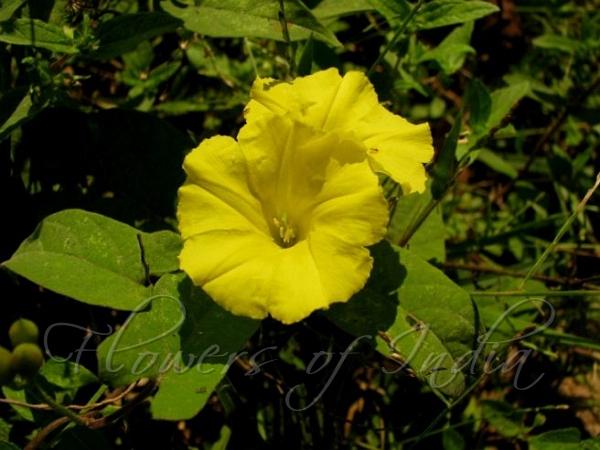|
| Yellow Hogvine |
|

|

| File size | 63054 |
| Original date | 12/20/10 1:05 PM |
| Resolution | 656 x 492 |
| Flash | Flash did not fire, auto |
| Focal length | 6.0mm |
| Exposure time | 1/1600s |
| Aperture | 3.2 |
| Focus Distance | |
| Metering Mode | Multi-segment |
| Camera make | Canon |
| Camera model | Canon PowerShot S5 IS |
| Sensor type | OneChipColorArea |
|
|
|
|
Photo: Prashant Awale |
Botanical name: Camonea umbellata Family: Convolvulaceae (Morning glory family)
Synonyms: Convolvulus umbellatus, Merremia umbellata, Ipomoea polyanthes
Synonyms: Convolvulus umbellatus, Merremia umbellata, Ipomoea polyanthes
Yellow Hogvine is a twining, herbaceous, more or less
hairy vine, with slender stems, spread throughout the tropical world. The
leaves are oblong to oblong-ovate, 8-12 cm long, pointed at the
tip and heart-shaped at the base. The inflorescence bears many flowers, and
is borne in the axils of the leaves. The sepals are about 6 mm long. The
flower is white or yellow, tubular-funnel-shaped, and about 3 cm long.
the limb is about 3 cm long. The capsule is ovoid, smooth, and about 1 cm
long. The seeds are covered with spreading, black or brown hairs.
Medicinal uses: A decoction of the plant is said to act
as a deobstruent, a diuretic, and an alterative, being useful in
rheumatism, neuralgia, headache, etc. It is used also for dropping into the
ear in cases of auricular ulcers, abscesses, etc. In epilepsy, the powder
of the leaves is sniff up. A paste or powder made of the root, mixed with
Java flour and water, is applied to swellings. The leaves are used in the
Moluccas as an emollient for abscesses and ulcers. In Bengal the seeds,
soaked in water, yield a mucilage which is used as an aperient, and as an
alterative in cutaneous diseases.
A decoction of the plant is said to act
as a deobstruent, a diuretic, and an alterative, being useful in
rheumatism, neuralgia, headache, etc. It is used also for dropping into the
ear in cases of auricular ulcers, abscesses, etc. In epilepsy, the powder
of the leaves is sniff up. A paste or powder made of the root, mixed with
Java flour and water, is applied to swellings. The leaves are used in the
Moluccas as an emollient for abscesses and ulcers. In Bengal the seeds,
soaked in water, yield a mucilage which is used as an aperient, and as an
alterative in cutaneous diseases.
Medicinal uses:
 A decoction of the plant is said to act
as a deobstruent, a diuretic, and an alterative, being useful in
rheumatism, neuralgia, headache, etc. It is used also for dropping into the
ear in cases of auricular ulcers, abscesses, etc. In epilepsy, the powder
of the leaves is sniff up. A paste or powder made of the root, mixed with
Java flour and water, is applied to swellings. The leaves are used in the
Moluccas as an emollient for abscesses and ulcers. In Bengal the seeds,
soaked in water, yield a mucilage which is used as an aperient, and as an
alterative in cutaneous diseases.
A decoction of the plant is said to act
as a deobstruent, a diuretic, and an alterative, being useful in
rheumatism, neuralgia, headache, etc. It is used also for dropping into the
ear in cases of auricular ulcers, abscesses, etc. In epilepsy, the powder
of the leaves is sniff up. A paste or powder made of the root, mixed with
Java flour and water, is applied to swellings. The leaves are used in the
Moluccas as an emollient for abscesses and ulcers. In Bengal the seeds,
soaked in water, yield a mucilage which is used as an aperient, and as an
alterative in cutaneous diseases. | Identification credit: Prashant Awale | Photographed near Radhanagar Beach, Havelock Island, Andaman. |
• Is this flower misidentified? If yes,